Question from Aura, Drawing Academy student
Hi,
I’m planning to attend a figure-drawing class locally. Do you have any advice on how to get the most out of it, how to maximize my learning? I’m going to study anatomy – again. I have studied it twice but never put it to practice and forgot most of it. I was thinking of tackling human body parts separately, studying the anatomy of the hand and/or arm, for instance, by reading on it and doing drawings of the bones and muscles, and then concentrating on drawing just that for maybe a couple of lessons. (There are about 30 lessons total.) Is that a good idea? What would you recommend? Should I concentrate on proportion first?
I just read this in the “How to improve figure and portrait drawing?” question/article: “Here’s my advice: learn constructive drawing principles and proper drawing techniques, learn human anatomy for artists, study human body proportions, draw from life whatever you see around you, get proficient tonal rendering skills, then come to drawing portraits and figures.”
Which kind of makes me question the usefulness of life-drawing classes. I have been learning these things, but (obviously) I haven’t mastered them. I’ve been drawing myself in the mirror, mostly arms and legs in different perspectives, and it feels like it has been useful; I wasn’t able to imagine such things before, and I’ve noticed more anatomical inaccuracies in other people’s drawings. I’m sure I would’ve improved more had I studied anatomy simultaneously.
Here’s a life drawing from where I used myself as a model to give you an idea of my level.
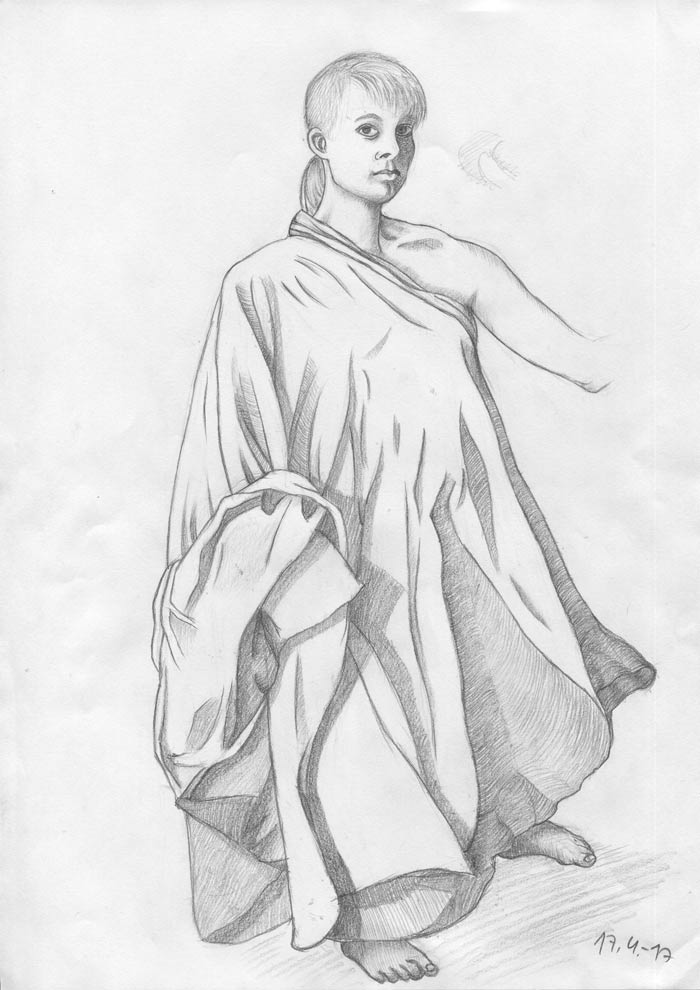
I ran out of steam, so some of it is pretty bad (the eyes and right foot especially), and sadly I drew this based more on what I see than what I know. I’m sure the time allowed per drawing will also be much, much shorter in the class.
I just don’t want the course to end come spring and realize I spent the whole time mindlessly drawing what I saw instead of learning and improving as much as one can in such a short time.
Thank you!
Aura
Hi Aura,
Many thanks for your drawing and questions.
I really like your artwork. You clearly put a lot of effort into capturing the likeness, and the artwork is well-rendered. Great job!
However, you need to practice life drawing keeping proportions in mind.
In your drawing, the portrait is great, but the body is out of proportion. The shoulder and the arm on the right are too big, and the legs are too short.
You have captured the reason why this drawing didn’t come out quite right – you drew what you saw, not what you know.
You know that a head fits into a human body seven and a half to eight times. You also know that the elbow of an arm hanging would be approximately at the level of the ribcage’s end. Yet in your drawing, should you put the arm down, the elbow would be somewhere in the pelvis region, and the right hand would easily touch the leg below the knee.
Such disproportion is possible with photo-perspective. Having seen so many photo images, we get used to misjudging proportions in drawing. So, drawing what you know instead of what you see is the way to make realistic, well-proportioned life drawings.
Now, about your life-drawing class
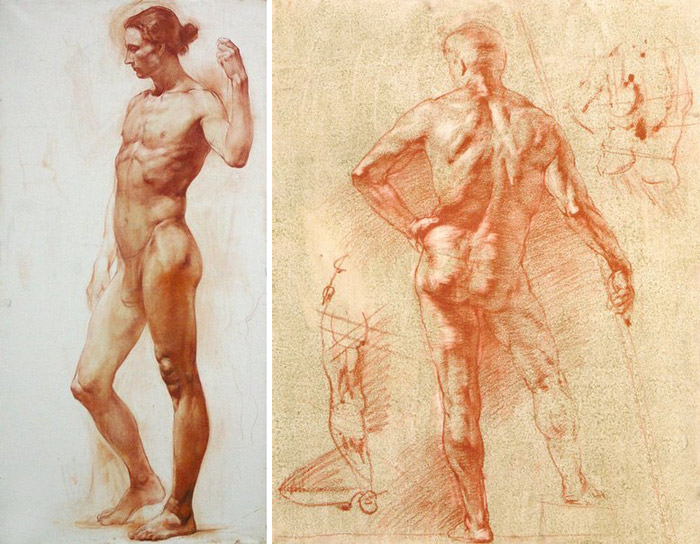
The main challenge you will face is that in most classes, a teacher or tutor sets up timing that doesn’t help students learn good drawing skills. Most likely, your sessions will start with very short two- to five-minute sketches of poses chosen by a model. That’s a great exercise for someone who has really strong life-drawing skills and is in search of inspiration or a particular pose. For a beginner and even an advanced art student, to begin with gesture drawing is a very hard task. So, be prepared that half of your time will likely be lost on making sketches you are not ready for.
After very fast sketches, a tutor will probably set the timer for ten- to twenty-minute poses. This also will be lost time for you. Although fifteen minutes is long enough to make a meaningful drawing, it is still a very shallow exercise to get what it takes to draw proportionate and well-rendered life drawings.
A life-drawing session might end up with a “long” pose for thirty or forty minutes. By classical education standards, this is a short sketch. Real education starts when you study a twenty- to forty-hour pose. This would not be the case in your life drawing class.
Here’s the truth about life drawing: depicting a human body requires a great deal of understanding and practice of constructive drawing principles, perspective, anatomy, and proportions. Should you have some gaps in those skills, all will come out as mistakes in your figurative artworks.
In classical curriculum, students do not start learning those principles on live models; instead, they spend years on drawing still-lives, draperies, muscle écorché, skeletons and skulls, classical sculptures, and busts before moving to drawing live people.
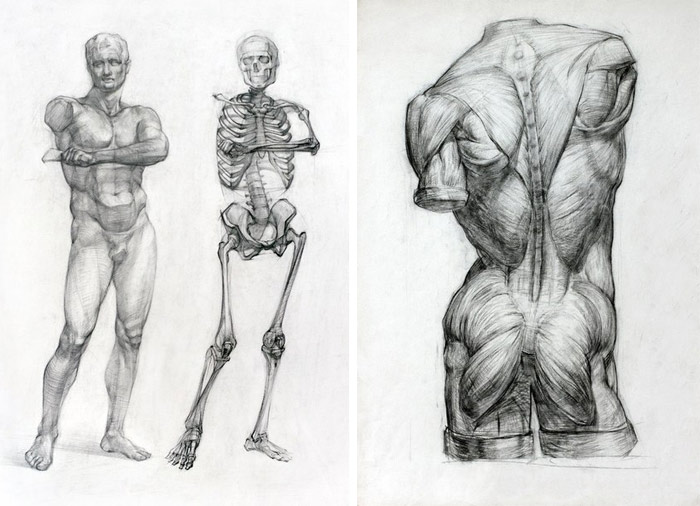
Do not get me wrong here – I really advocate drawing from life at every opportunity and attending a life-drawing class will be great thing to do. However, whether you would get the most out of it is questionable.
Here’s the ideal scenario of getting ready for life drawing: After learning and practicing the topics mentioned above – constructive drawing principles, anatomy and proportions – a student would need to spend a good deal of time drawing long poses: four to twenty hours per artwork. Speed and gesture-sketching is not important at that time. A student needs to develop the necessary skills of drawing human figures and portraits in the right sequence of steps, learning the necessary proportions and applying the knowledge in practice. When the foundation of life drawing is in place, and a student can apply the knowledge of anatomy and proportions with ease, almost on autopilot, then moving to faster sketches will be the next step forward.
Making gesture sketches is great for any artist who is serious about figurative drawing. However, speed and skills are products of extensive practice.
I will give you an example of why many contemporary life-drawing classes are not fit for the purpose of good learning. Let’s say you want to learn how to drive a car. You do not come to the Formula 1 track and take the fastest car available. If you do, you won’t be able to start, and even if you start, every attempt at driving fast will result in crash after crash. Instead, you go to a driving school and take driving lessons – slowly, step by step, learning theory and doing practical exercises, starting to drive around, getting many hours of driving and eventually moving to faster tracks and highways. With time, more precision, speed, and control will become natural to you. It’s the same with drawing. Starting with fast gesture sketches without the necessary skills is like driving a sports-car without first acquiring a driving licence.
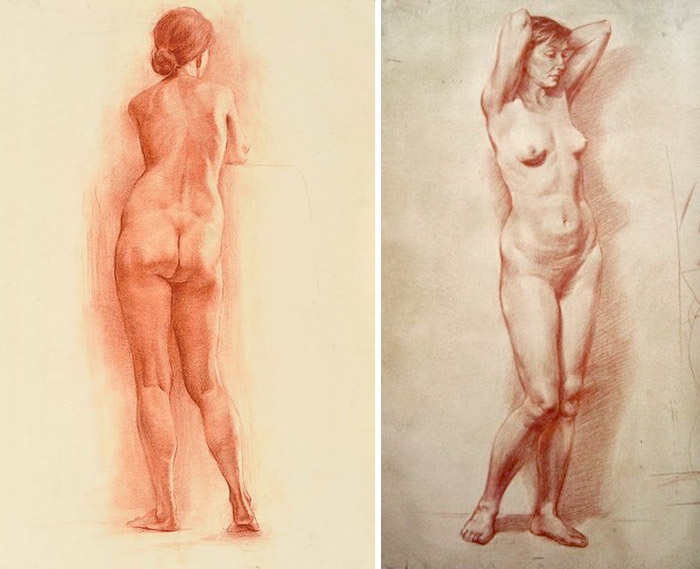
Now, how to benefit from your life-drawing class
If you can’t control timing of poses, there are still certain things you can do:
1. Use a well-sharpened graphite pencil – 2B is good enough for the job. Sharpen several pencils at once to save time during drawing.
2. Avoid using charcoal and sanguine, even though you might be advised to use them by a tutor. Charcoal is good when big areas need to be covered with black dust. So what? There is no benefit in that for learning. You need to develop precision and control. Artistic smearing of media is secondary and is only good when it accompanies strong drawing skills. Sanguine, colored chalks and pencils look attractive on paper, and therefore students do not notice mistakes in constructive drawing, anatomy, and proportions. When you have developed good drawing skills in graphite, it makes sense to move further and use “more artistic” mediums to solve your creative tasks. For now, stick to plain and “disciplined” graphite pencils.
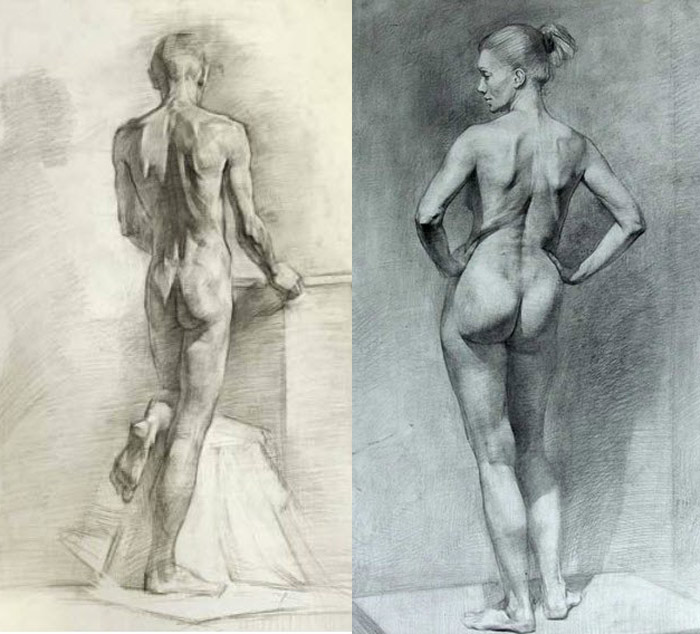
3. Do fast gesture sketches on a small scale. Do not try to create an A3 or A2 artwork in ten minutes. Fill one sheet of paper with multiple sketches.
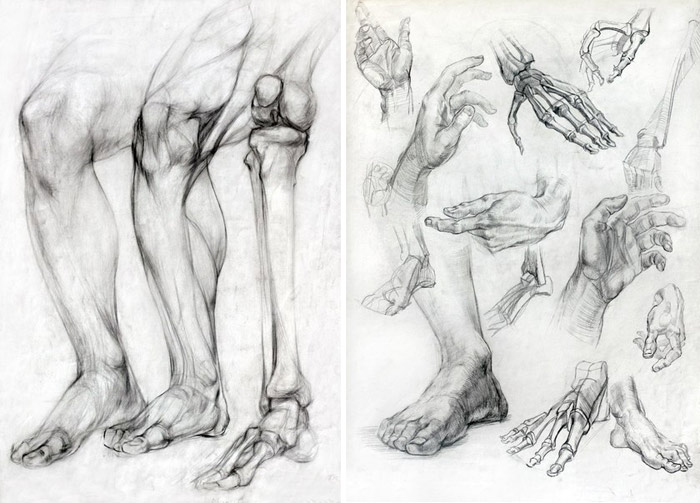
4. However short the pose is, draw it with proportions in mind. It is not about capturing the likeness or completing the whole figure. It is about how thoughtfully you do a sketch. Draw what you know; don’t copy what you see. When drawing, constantly solve questions about proportions and anatomy. Check and re-check all the proportions you know on the model and in your drawing. The moment you stop solving such questions, you stop drawing constructively what you know and start copying what you see.

5. Instead of full-figure short sketches, you may do smaller tasks – drawing a hand, a nose, a torso, or capturing the bend of a ribcage, for example.
6. However “long” a pose is, spend the whole time on constructive drawing; do not attempt tonal rendering, especially if you feel that the figure or a portrait drawing is not good enough. Rendering tones of a badly drawn figure is like painting walls of a house that is built unsoundly and is about to collapse – just a waste of time and materials. Do not make the junior mistake of thinking that by depicting lights and shadows you will improve your drawing.
7. Do not be afraid to erase and re-draw figures as many times as required. It is not about making a “lovely-looking” artwork but learning how to make a well-proportioned and truthful image of a figure. All your life-drawing class artworks will be just exercises, not works for an exhibition.
8. Keep in mind that perspective for life drawing is different from perspective as you know it. This is illustrated vividly in your drawing. By looking in a mirror, you copied what you saw – the head from the eye-level and feet from above. This is an amateur mistake. When the distance to the model is less than six times of the model’s height, you need to draw it from different points of view – the head from the eye-level, and when drawing feet, bend or sit down to look at feet from the lower point of view. This way you will avoid photo-perspective and apply a parallel perspective when foreshortening is in place, but drastic distortions are minimized.
9. When you do longer drawings, do two sketches on the same scale next to each other – a model’s figure or a portrait and an imaginary skeleton or skull from the same point of view. You can also place the most prominent muscles on bones. This would be the most useful exercise you do during your life drawing sessions. Needless to say, studying a human anatomy is a must for figurative artists – you need to know how bones and muscles look without looking for a reference.
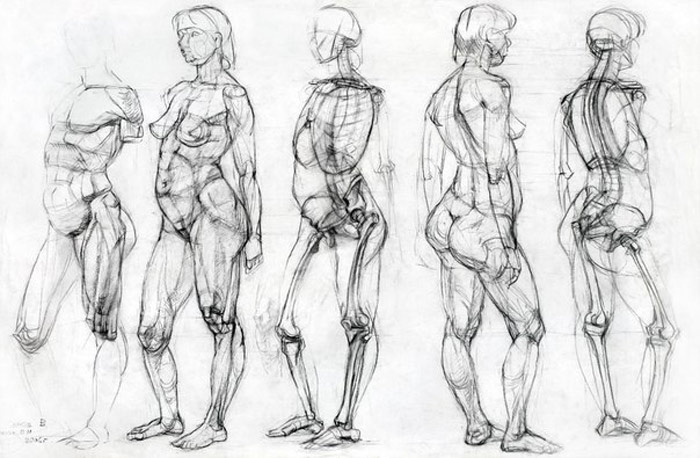

10. Mark proportions on your drawings. You may mark key points with letters or draw lines with marks. Whatever way you do it, this knowledge will “engrave” itself in your mind, so next time you will apply correct proportions without thinking much about it.
11. Have a plan for your thirty lessons – I mean your own plan, not what an art tutor might have (if he or she has one at all). Set up meaningful tasks of what you want to learn and achieve. You may study one particular area of a human body at a time – a head, a shoulder region, a torso, limbs… Study anatomy for artists of that area at home, make anatomy sketches, and take those sketches with you to the life-drawing class. Apply what you have learned at home to your life drawing.
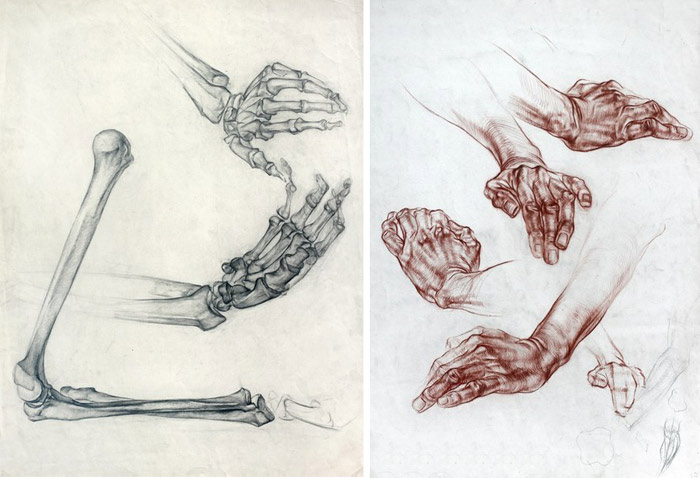
12. Get motivation from competing with yourself, not with other students. Your fellow students might have a totally different levels of drawing skills and move at a different speed. Mind your own education.
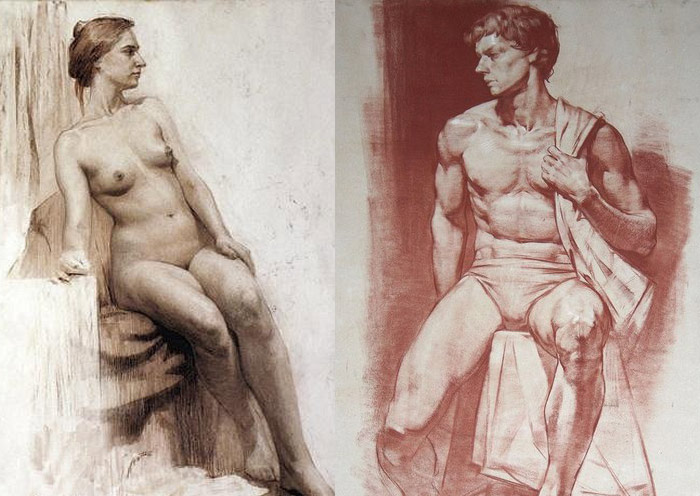
I hope this gives you enough to think about and get prepared for your life-drawing class.
I wish you the creative success you deserve.
Best regards,
Vladimir London
Drawing Academy tutor






Hi,
thank you so much for the great, in-depth advice! It’s really given me a lot of food for thought and I’ll be rereading it many, many times.
I know that dong life drawing is a great thing to do, but I also need to draw still lifes etc. at home, which, of course, I’ll be doing that anyway.
I’m sure I can request somewhat longer poses, though they won’t be long enough by any means. I want to learn effectively and not waste my time. I suppose I could draw a bust instead while the poses are extra short.
Could I show your reply or some of it to the “teacher” should I go ahead with the course? I’m sure she doesn’t know most of this even though she has graduated from an “art academy.”
Thank you so much again for the great advice! Have a nice day,
Aura
You are very welcome : ) I hope you will learn a lot from your life drawing sessions
Best regards,
Vladimir London
Wow, what a great article! I’m drawing for more than 20 years and often attend life drawing drop-in sessions, but no one ever told me why to this day my sketches sucks ;)
Every time I do life sketching, it’s racing rather than drawing. Your example with a sport car explains everything!
I’m actually a member of the http://anatomymasterclass.com/ and what I’ve learned there in just a few weeks is by far succeeds all my professors ever taught me during 4 years in the uni. I could only wish finding this site before getting into £50K+ student debt, which is still growing BTW :/
is it pounds sterling? I really like this online course and signing in the Drawing Academy now!
Hi, nice advice on drawing a figure, I am a self taught artist and I would like to learn how draw figures correctly and with confidence
Thank you,
Rasheed Ally
I am simply gobsmacked! This is “the” most wonderful and magnificent narrative on drawing I have ever read or heard (including my four lost years in an Art Curriculum at an accredited University)–it is the most significant statement of truth regarding the Fine Art of Drawing. There are no words invented that can describe the honesty of these words or describes the elegance of the instructors knowledge.
Initially I was reluctant to subscribe to this program but now, this narrative makes all the difference. I ponder whether I should continue with the Anatomy Master Class program until I have developed still life skills along with honing my skills in perspective and proportions.
Humble I thank you.
Of the many articles in this series, this one stands alone. As an experienced designer and design educator I have taught drawing and sketching for designers at one of the premier programs in the U.S. This sort of “object drawing” was a mystery for many fine arts students, nevertheless, it was no cakewalk for my design students. At one point our Foundations department brought in a couple of atelier based instructors who turned things in a positive direction with their meticulous construction of wooden toys and other basic shapes. My students would often complain about this; to which I would really tee off on them, explaining that in order to sketch quickly (with authority) they must learn slow–ever so slow–drawing. You have completed the path, and done it such that the early-stage students to whom you are addressing can absorb it. Constructively teaching constructive drawing.
Nice job.
Thank you Vladimir!
You are very articulate and provide valuable direction.
The old saying, ” How do you get to Carnegie Hall?…
Practice, practice, practice!”
Is the the secret!
Thank you!